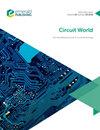Neutral-point-clamped inverter based synchronous reluctance motor drive for solar pump application
IF 0.7
4区 工程技术
Q4 ENGINEERING, ELECTRICAL & ELECTRONIC
引用次数: 0
Abstract
Purpose Industrial drives require appropriate control systems for reliable and efficient performance. With synchronous reluctance machines (SynRMs) slowly replacing the most commonly used induction, switched reluctance and permanent magnet machines, it is essential that the drive and its control be properly selected for enhanced performance. But the major drawback of synchronous reluctance motor is the presence of high torque ripple as its design is characterized by large number of variables. The solutions to reduce torque ripple include design modifications, choice of proper power electronic inverter and PWM strategy. But little has been explored about the power electronic inverters suited for synchronous reluctance motor drive to minimize torque ripple inherently by obtaining a more sinusoidal voltage. The purpose of this paper is to elaborate on the potential multilevel inverter topologies applicable to SynRM drives used in solar pumping applications. Design/methodology/approach The most significant field-oriented control using maximum torque per ampere algorithm for maximizing the torque production is used for the control of SynRM. Simulation results carried out using Matlab/Simulink are presented to justify the choice of inverter and its control technique for SynRM. Findings The five-level inverter drive gives lesser core or iron losses in the SynRMin comparison to the three- and two-level inverters due to lower Id current ripple. The five-level inverter reduces the torque ripple of the SynRM significantly in comparison to the three- and two-level inverter fed SynRM drives. The phase disposition-PWM control method used for the inverter shows the least total harmonic distortion (THD) levels in output voltage compared with the other level shifted PWM techniques. Originality/value Among the available topologies, a fitting topology is proposed for use for the SynRM drive to have minimal THD, minimal current and torque ripple. Additionally, this paper presents various modulation techniques available for the selected drive system and reports on a suitable technique based on minimal THD of output voltage and hence minimal torque ripple.基于中性点箝位逆变器的太阳能泵同步磁阻电机驱动
目的工业驱动器需要适当的控制系统来实现可靠和高效的性能。随着同步磁阻电机(SynRM)慢慢取代最常用的感应电机、开关磁阻电机和永磁电机,正确选择驱动器及其控制以提高性能至关重要。但同步磁阻电机的主要缺点是存在高转矩脉动,因为其设计具有大量变量的特点。减少转矩脉动的解决方案包括设计修改、选择合适的电力电子逆变器和PWM策略。但是,对于适用于同步磁阻电机驱动的功率电子逆变器,很少有人探索通过获得更正弦的电压来固有地最小化转矩纹波。本文的目的是详细阐述适用于太阳能泵送应用中的SynRM驱动器的潜在多级逆变器拓扑结构。设计/方法/方法使用每安培最大转矩算法最大化转矩产生的最重要的面向现场的控制用于SynRM的控制。使用Matlab/Simulink进行的仿真结果证明了SynRM逆变器及其控制技术的选择是合理的。由于Id电流纹波较低,与三电平和二电平逆变器相比,五电平逆变器驱动在SynRM中的核心或铁损较小。与三电平和两电平逆变器供电的SynRM驱动器相比,五电平逆变器显著降低了SynRM的转矩脉动。与其他电平偏移PWM技术相比,用于逆变器的相位配置PWM控制方法显示出输出电压中最小的总谐波失真(THD)水平。独创性/价值在可用的拓扑结构中,提出了一种适合SynRM驱动器的拓扑结构,以具有最小的THD、最小的电流和扭矩纹波。此外,本文介绍了适用于所选驱动系统的各种调制技术,并报告了一种基于输出电压的最小THD和最小转矩纹波的合适技术。
本文章由计算机程序翻译,如有差异,请以英文原文为准。
求助全文
约1分钟内获得全文
求助全文
来源期刊

Circuit World
工程技术-材料科学:综合
CiteScore
2.60
自引率
0.00%
发文量
33
审稿时长
>12 weeks
期刊介绍:
Circuit World is a platform for state of the art, technical papers and editorials in the areas of electronics circuit, component, assembly, and product design, manufacture, test, and use, including quality, reliability and safety. The journal comprises the multidisciplinary study of the various theories, methodologies, technologies, processes and applications relating to todays and future electronics. Circuit World provides a comprehensive and authoritative information source for research, application and current awareness purposes.
Circuit World covers a broad range of topics, including:
• Circuit theory, design methodology, analysis and simulation
• Digital, analog, microwave and optoelectronic integrated circuits
• Semiconductors, passives, connectors and sensors
• Electronic packaging of components, assemblies and products
• PCB design technologies and processes (controlled impedance, high-speed PCBs, laminates and lamination, laser processes and drilling, moulded interconnect devices, multilayer boards, optical PCBs, single- and double-sided boards, soldering and solderable finishes)
• Design for X (including manufacturability, quality, reliability, maintainability, sustainment, safety, reuse, disposal)
• Internet of Things (IoT).
 求助内容:
求助内容: 应助结果提醒方式:
应助结果提醒方式:


